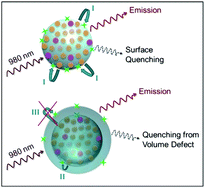Water dispersible ultra-small multifunctional KGdF4:Tm3+, Yb3+nanoparticles with near-infrared to near-infrared upconversion
Abstract
Ultra-small multifunctional KGdF4:Tm3+,Yb3+

* Corresponding authors
a
Department of Chemistry and Biochemistry, Concordia University, 7141 Sherbrooke Street West, Montreal, QC, Canada
E-mail:
capo@vax2.concordia.ca
b
Department of Applied Physics and Materials Research Centre, The Hong Kong Polytechnic University, Hung Hom, Hong Kong, People's Republic of China
E-mail:
apjhhao@inet.polyu.edu.hk
c Institut National de la Recherche Scientifique - Énergie, Matériaux et Télécommunications, Université du Québec, 1650 Boul. Lionel-Boulet, Varennes, QC, Canada
Ultra-small multifunctional KGdF4:Tm3+,Yb3+

 Please wait while we load your content...
Something went wrong. Try again?
Please wait while we load your content...
Something went wrong. Try again?
H. Wong, F. Vetrone, R. Naccache, H. L. W. Chan, J. Hao and J. A. Capobianco, J. Mater. Chem., 2011, 21, 16589 DOI: 10.1039/C1JM12796A
To request permission to reproduce material from this article, please go to the Copyright Clearance Center request page.
If you are an author contributing to an RSC publication, you do not need to request permission provided correct acknowledgement is given.
If you are the author of this article, you do not need to request permission to reproduce figures and diagrams provided correct acknowledgement is given. If you want to reproduce the whole article in a third-party publication (excluding your thesis/dissertation for which permission is not required) please go to the Copyright Clearance Center request page.
Read more about how to correctly acknowledge RSC content.
 Fetching data from CrossRef.
Fetching data from CrossRef.
This may take some time to load.
Loading related content
